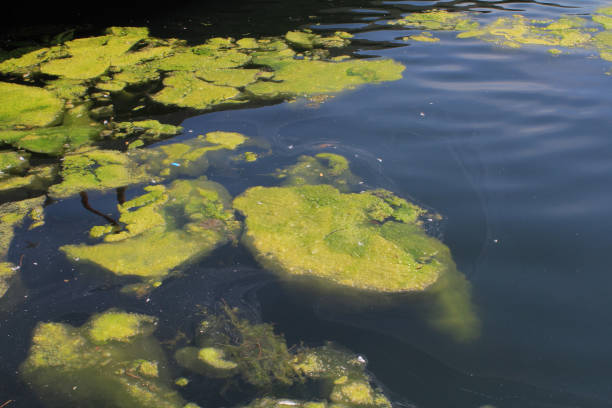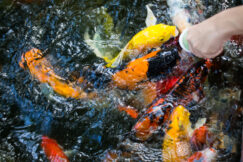Algae in your pond do not always have to be a bad thing. In reality, having some green algae (not blue-green algae) in your backyard pond is considered healthy and required for aquatic ecosystems since it photosynthesizes, produces oxygen, and serves as a natural food source for many fish, insects, and other species.
Algae, on the other hand, may destroy everything in your pond if allowed to grow out of control since it consumes all nutrients and dissolved oxygen levels.
While we’ve written an article on algae growth and how to prevent it. This one we like even more because we get to add more fish to our pond!
Using various pond fish, such as those listed below, is an environmentally friendly, straightforward technique to guarantee that algae populations remain balanced and sustainable.
Although pond fish are unlikely to entirely control a fast algae bloom (more on this later), they are an excellent natural approach for limiting its growth in conjunction with more traditional methods.
Before we get to the top algae eaters, it’s important to understand that while feeding your fish, don’t feed them more than they can consume in five minutes. Any uneaten food will add nutrients to the water, increasing algae development.
Furthermore, with fewer additional feedings, your fish are more likely to eat any algae there. An automated feeder to properly manage dose and frequency might be beneficial in these cases.
What factors should I consider while selecting an algae eater for my pond?
To evaluate if a certain fish can live and prosper in your pond, many crucial aspects of the pond’s environment and occupants must be considered.
To choose the best algae eater from our list, make a note of the following variables in your pond:
Water temperature
To begin, consider your normal year-round temperature. Some fish are better adapted to a warmer temperature and will not survive, but others will require special care to survive a harsh winter. Some of our suggested algae eaters may not withstand the harmful impact of high temperatures on ponds if you reside in a warmer climate with temperatures above 70 F.
Size and depth
The size and depth of the pond are the next most essential considerations. Will your tiny pond be large enough to handle larger fish as they grow? Half of the algae eaters on our list require at least 1,000 gallons of water to survive, and one can grow to be 4’6″ tall. Are you unsure of the size of your pond? Read on to learn how to measure the size of your pond.
Other pond inhabitants and fish
This is a critical question to ask. Do your existing fish or creatures get along with your selected algae eater? Championship koi owners should consider seriously before introducing any fish that may be aggressive to a valued fish!
Ph level
What is the pH of the water in your pond? Choose an algae eater that is compatible with your current circumstances. Otherwise, your new fish may suffer.
What kind of algae is in your pond
Consider the sort of algae you see, how much you need to eliminate, and where the algae are most prevalent in your pond to help you decide which fish will eat it.
Best algae-eating fish for your koi pond
Goldfish and Koi
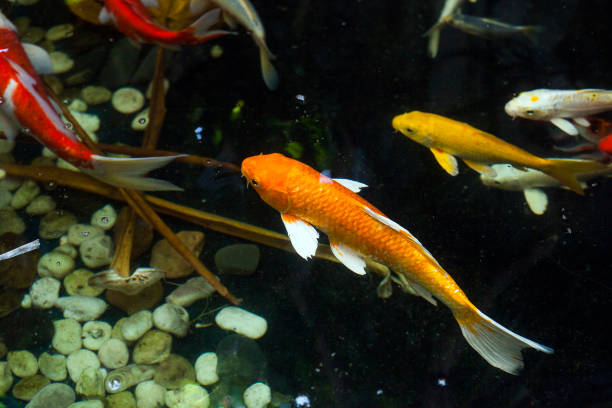
Because koi and goldfish are two of the most popular pond species, you’ll be relieved to know that both are omnivores and will eat algae to some extent.
However, algae are not their primary food source, and they often graze more extensively on algae only during the winter, when they are more inactive and have fewer food alternatives. During the warmer months, fish species prefer to consume their usual diet and any pond insects in your water garden.
More goldfish or koi in your pond can assist guarantee that more algae are eaten. Still, if you have a substantial amount of algae development, you may also want to include additional algae-eaters.
Plecos get along quite fine with koi, but if there isn’t much swimming room in your pond, they may mistakenly grasp onto smaller goldfish and destroy their scales and required slime covering.
Suppose you are concerned about the possible complications of introducing other fish species. In that case, we recommend that you use alternate ways of algae management since both goldfish and koi like different types of grub!
Common Pleco
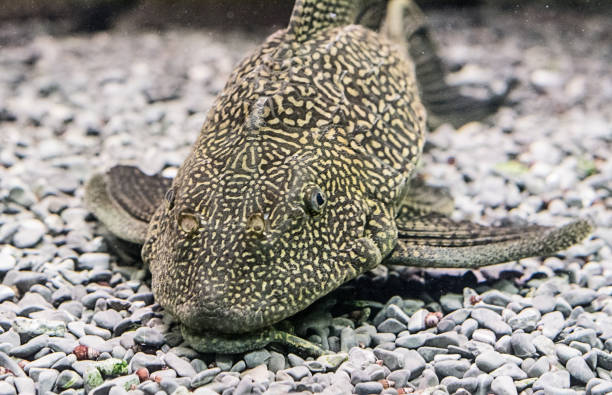
The common pleco (Hypostomus plecostomus), sometimes known as the suckermouth catfish, is an omnivorous pond fish that feeds on algae, plant detritus, and insects. It may grow over 24 inches long and is known to be aggressive as an adult, so only keep one pleco in your pond at a time.
Mosquito Fish
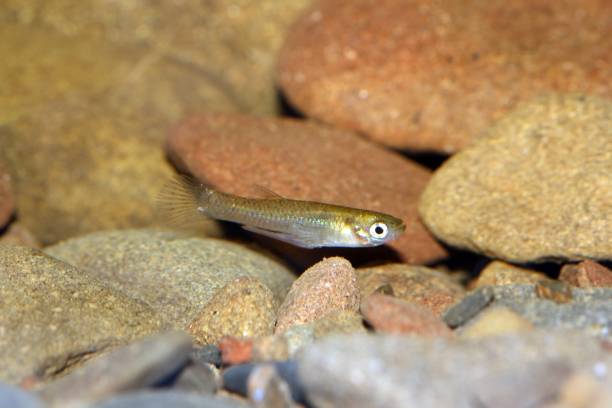
Mosquitofish (Gambusia affinis) are freshwater fish that consume mosquito larvae. Mosquitoes breed in a variety of backyard sources of water, including ponds. Mosquitofish get along with most ornamental pond fish, although they get along best with species their size because larger fish devour mosquitofish. If you keep mosquito fish among larger fish, ensure they have lots of hiding places, such as rocks and plants.
Siamese Algae Eater
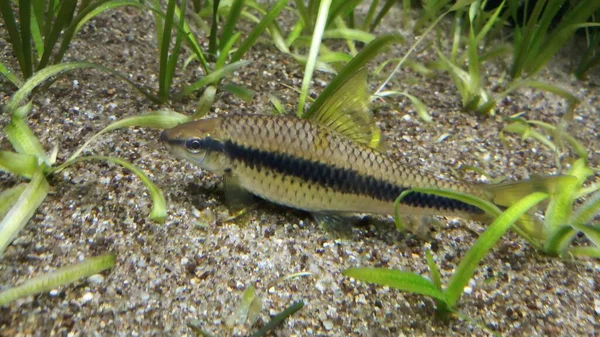
The Siamese Algae Eater (Gyrinocheilus aymonieri) is a big Asian pond fish. It may grow 11 inches long and utilizes its sucker-like mouth to remove algae from rocks, vegetation, and the pond’s edges. Because the Siamese Algae Eater might be territorial, try it with various pond fish to see whether it’s compatible.
Flying Fox

A double misunderstanding: not only is this a fish, but the gliding animal you may have imagined is also not a fox. Our flying fox is a little but very hungry fish that grows to be four to six inches long and feeds primarily on algae. It favors the simpler, more useful algae over bigger types, as do the other smaller fish on this list, making summertime bloom avoidance its major advantage.
Flying foxes are lively fish that get along well with other species. However, this is not always the case. Because of their frivolity, they frequently compete fiercely with others of their species. In addition, they like smaller ponds and higher temperatures, especially over 70°F.
Pond Loach (Misgurnus anguillicaudatus)

They’re tough fish that can live in water temperatures ranging from 40 to 77°F, making them ideal for new pond owners. They may grow to be a foot long and like to live in small groups, but if they’re gentle, they should be comfortable in a community of other species.
Because loaches are opportunistic feeders who eat insects, plant materials, and food pellets, they do not consume as many algae as certain plecos.
They are, however, one of the few algae eaters that can not only live in but enjoy colder water, making them an excellent choice for pond owners who have cooler temperatures all year. If you have severe winters, bring them indoors as much as possible or install a pond heater to keep them warm.
Grass Carp
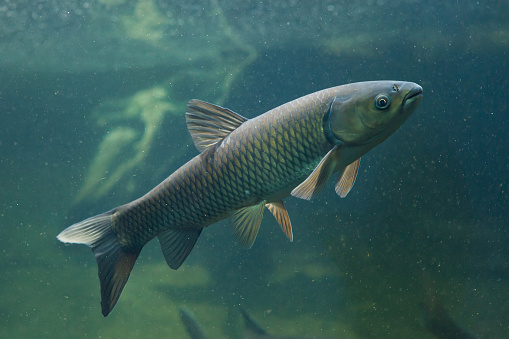
Grass carp (Ctenopharyngodon Idella) are voracious eaters, consuming 40 to 300 percent of their body weight in plant material daily. They consume algae but are picky eaters, preferring rooted food such as grass on the pond’s edge. Grass carp, on the other hand, are excellent alternatives for the long-term management of rooted vegetation.
Channel catfish
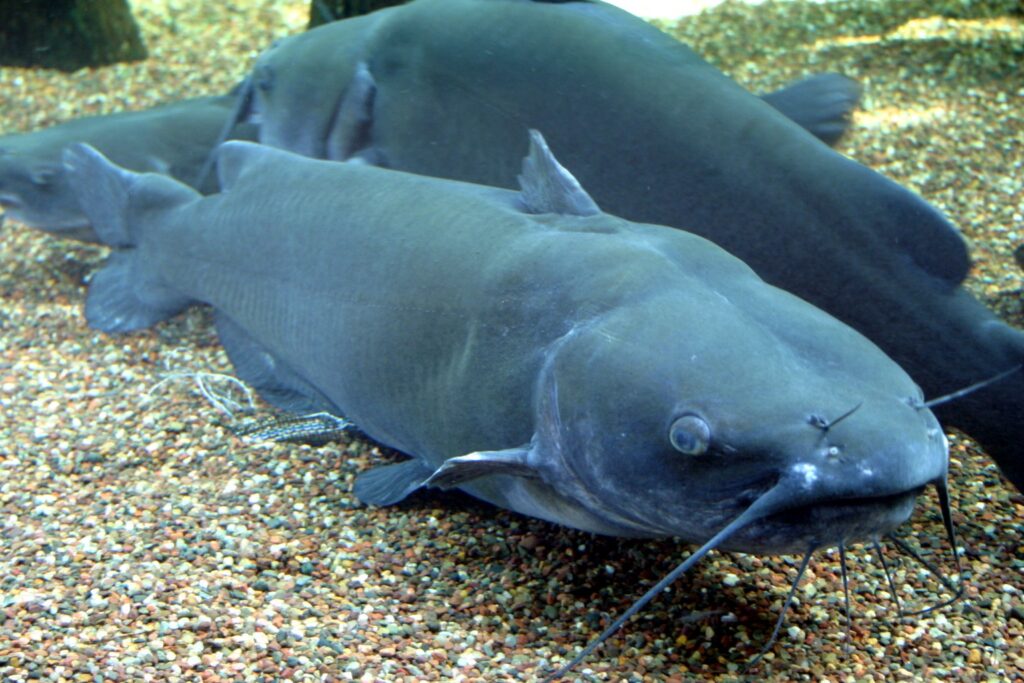
The channel catfish is another species only suitable for big ponds (1,000+ gallons). Because of their whisker-like tendrils, they resemble catfish to most of us. They’re a scavenger/bottom feeder that consumes almost anything in their path.
They have a keen sense of smell, which aids them in locating large amounts of algae. They’ll eat just about anything in big amounts. Therefore, they should not be supplied with larger fish.
Channel cats thrive at water temperatures ranging from 70 degrees Fahrenheit to 8.5 degrees Fahrenheit, with pH values ranging from 7.5 to 8.5.
Guppies and Mollies
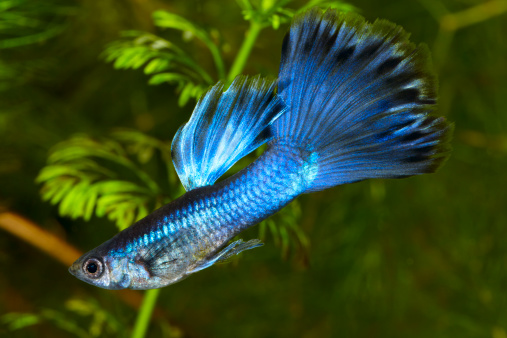
Like many other popular pond fish, Mollies and guppies demand a diversified diet. Therefore one little guppy won’t be able to stop an algae bloom.
However, since they reproduce so fast, even a tiny beginning group of these microscopic fish can play a substantial role in preventing excess algal development (along with representing a food source for larger species).
Mollies and guppies prefer soft green algae—the most generally helpful type—over the more complicated forms that generate pond scum due to their size. They also like eating bug eggs and larvae, which aids in mosquito control in your pond.
These aren’t tough fish. Guppies thrive at temperatures over 55 degrees Fahrenheit, but mollies despise chilly temps and prefer water temperatures above 75 degrees. Because wintering over is not an option, they must be taken inside during the colder months or sold to pet retailers.
Chinese High-Fin Banded Shark

Batfish are friendly, preferring to dwell in small groups, and coexist nicely with smaller species (however, small fish, particularly guppies and immature goldfish, maybe accidentally hurt if they come into contact with a feeding batfish).
Because of their size and fondness for companionship, batfish can only be found in bigger ponds. It is not uncommon for well-fed batfish to grow to be over four feet long.
They enjoy lower temperatures as well. But, like most other catfish, batfish are prepared to wait out even hard winters as long as some surface water stays unfrozen.
Black Japanese Trapdoor Pond Snails
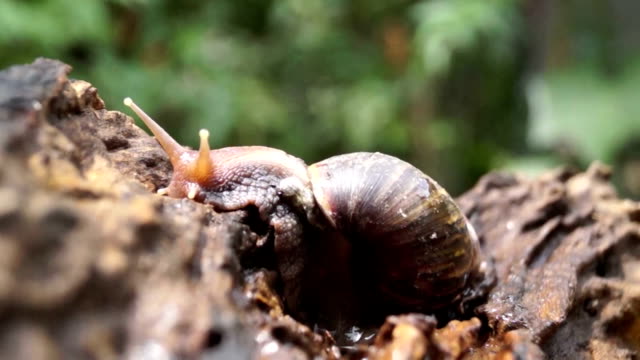
Trapdoor snails are an alternative to sucker fish for outdoor ponds. These enormous, living snails consume algae and can tolerate frigid conditions. Unfortunately, these snails also eat rotting fish food, fallen leaves, and other filth of the pond’s bottom and edges. These snails may grow to be around 3 inches long. Calculate one snail for every three square feet of pond space.
What kinds of algae will fish consume?
Algae-eating fish will consume any green algae, including carpet algae and filamentous / hair/string algae, but not planktonic algae that generate green water in new ponds or the more toxic Cyanobacteria, sometimes known as blue-green algae.
Is it necessary to have algae eaters in my pond?
Algae have had a poor rap among pond owners. And with reason: algae grow so quickly, especially in the summer, that they may swiftly drain a pond’s stocks of nutrients and dissolved oxygen.
However, algae are more than simply annoyances: they play a complicated function in the health of your pond and need careful treatment.
Some algae get a poor rap regardless of the conditions. Filamentous algae, such as Spirogyra, play no significant part in the food chain of a healthy pond and are frequently the first species to benefit from higher levels of nutrients such as phosphates and nitrates.
This advantage over more helpful species of algae frequently causes filamentous algae to proliferate aggressively in warmer temperatures, earning it the more widespread name: pond scum.
However, certain algae are essential to the health of your pond. The beneficial form of phytoplankton, single-celled green algae, is the initial link in a pond’s food chain and the foundation of its whole ecology.
Phytoplankton help oxygenate your pond; in fact, phytoplankton is responsible for an estimated 80% of the world’s oxygen production.
So the challenge isn’t to get rid of all algae. Instead, its purpose is to inhibit the growth of undesirable organisms such as filamentous and blue-green algae (phytoplankton that is a chlorophyll-producing bacteria) while promoting healthy levels of green phytoplankton.
Targeted pond algae control may be time-consuming and costly. Barley straw, floating in small sachets or added as a pellet or extract, is a classic method of absorbing excess nutrients before they cause algal blooms. However, when might deprive plants and fish of the same nutrients when used excessively.
- The original and best selling barley straw pond treatment from summit
- Keep your pond water clean and clear year-round
- Clear your pond, fountain and fish tank naturally
UV clarifiers destroy algae by reducing their capacity to reproduce; they perform best in smaller ponds and, like barley straw, should be handled with caution.
- Also available in 5
- 18
- 36 watt.
We may receive a commission at no extra cost if you use this link to purchase.
Pond owners may even vacuum up pond scum.
- Max. Suction depth: 6 ft.High-power suction to a depth of 59 inch.Maximum suction depth of 78 inch
- Suction hose length: 13 ft
- Operating voltage: 110-120 Volt / 60Hz. Power consumption: 1200-1400w
However, the most natural methods of controlling algae development may be the most effective. Paying close attention to groundwater and runoff can help reduce the harm posed by high levels of phosphates and nitrates.
The correct pond plant choices, particularly those that stand above the water’s surface, can limit algae development by shading significant areas of the pond’s floor. And the appropriate combination of the pond above algae eaters can keep algae levels in control all summer long, minimizing the number of their summer blooms.
None of these passive measures will eradicate the presence of hazardous algae, and they may not completely avoid yearly blooms if used collectively. However, by decreasing the baseline levels of harmful algae in the pond, they can greatly limit the potential of harmful algae to do their worst while encouraging helpful algae to thrive.
Last update on 2022-09-11 / Affiliate links / Images from Amazon Product Advertising API

